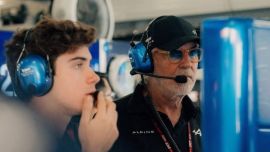Accompanied by a group of Argentine business leaders, Buenos Aires City Mayor Horacio Rodríguez Larreta travelled to San Francisco this week to attend the Global Climate Action Summit (GCAS), joining government officials, mayors and climate activists from across the world.
Larreta spoke exclusively with the Times at the summit, where he confirmed his intention to run for re-election in the nation’s capital, dismissing a presidential candidacy in 2019.
He offered his firm backing for plans to improve the subway rail system in the city, opened the door to electric buses on Buenos Aires’ streets and described the upcoming waste-toenergy plants as something that was simply “necessary.”
You’ve held several meetings with investors in Silicon Valley during your time here. What was the result?
We came with a group of 15 companies and two universities. We spoke with several investors here, venture capitalists. It was very interesting for the companies and for us to know what they need. We met with [company officials from] Google, Amazon and Salesforce and signed a commitment with WeWork to review the possibility of setting up a branch in Buenos Aires.
Could we expect any investments from them in the capital in the short term?
Amazon is reviewing the possibility of setting up a centre in Argentina. The idea is for them to install in Bahía Blanca. We hope our meeting helps achieve that goal.
Buenos Aires City committed itself to be carbon neutral by 2050. How are you progressing toward that goal?
We are pushing for people to use public transportation instead of their cars. We have the largest area in the world with a restriction to vehicles, focused in the downtown area. We will soon expand it to the area of Tribunales as well. We have reduced the number of vehicles that circulate in this area by 80 percent, thanks to the restriction.
Transportation is a key area to work on, in order to reduce emissions. What are your plans in that regards?
We implemented the Metrobus six years ago and now about one-and-ahalf million people use it per day, in line with an increase in the number of people using the subway. We are now in discussions with the national government for them to hand us over the control of the buses in the city. That will help us move toward electric systems.
What are your plans for electric buses?
There’s an initial plan by the national government to give us 50 electric buses. Now we can accelerate that by us managing the bus system. The idea is starting with the bus lines in the city centre as that’s where most of the pollution is. We could either implement it on the Metrobus at Avenida 9 de Julio avenue or in San Telmo.
How would you describe the current [Subte] subway service in the city, considering the wide complaints?
We added 300 new train carriages that have improved the frequency and allowed more people to travel. It’s a service chosen by a lot of people and that’s the best indicator. For many it’s the best way to travel. Many people travel tightly [squeezed in] on rush hour but it’s like in any other city of the world. We already purchased 80 more carriages that will improve the frequency even more.
Will the upcoming change in the company controlling the subway lead to a better service?
That’s our goal. All the proposals include the involvement of subway operating companies from around the world, so we’ll be having their experience. The immediate objective is adding those 80 carriages, improving the quality of the E-line. After that, if the credit conditions allow it, we can discuss building new subway lines.
Why did you choose waste-toenergy plants as the solution to waste management in the city?
We have to change the current system. We keep accumulating waste in landfills and that’s very old fashioned. The waste-to-energy plants allows us to deal with waste management and at the same time create energy. The most progressive cities in Europe use this technology, which is clean and doesn’t pollute.
Isn’t the choice of this system proof of the lack of progress toward recycling in the city?
No, the two are independent from each other. The more we can increase recycling the better. About 50 percent of the families in the city already recycle and six years ago no-one did. The fact that not everybody is recycling doesn’t mean it’s better to use waste-to-energy plants.
The legislature recently privatised a few areas in and around the former Buenos Aires zoo [now Eco-Park]. What’s the city’s long-term goal regarding the area?
It was previously fully privatised, and people had to pay to get in. Now we have ended that model. We are moving from that to an area partly privatised.
There’re still many animals that have to be moved. It’s a complex process and we are doing it very carefully. We want to have a place that combines education and awareness.
In the meantime, many animals have passed away. Are plans to transfer and move them away to new sites progressing at the right speed?
It’s the law of life. If you have 1,500 animals, some will pass away due to biological reasons. We have experts and veterinarians that look after the animals.
What are in the upcoming plans to make the City more energy efficient?
We’ll be one of the first cities in the world with public lighting fully based on LED lights. We have 125,000 lights in the city that will be based on that system by the end of the year. We will reduce our energy consumption by half because of it.
Will you consider a presidential candidacy for next year?
No, I still have many things to do in the Buenos Aires City. The most natural thing to do would be continue working in the City




















Comments